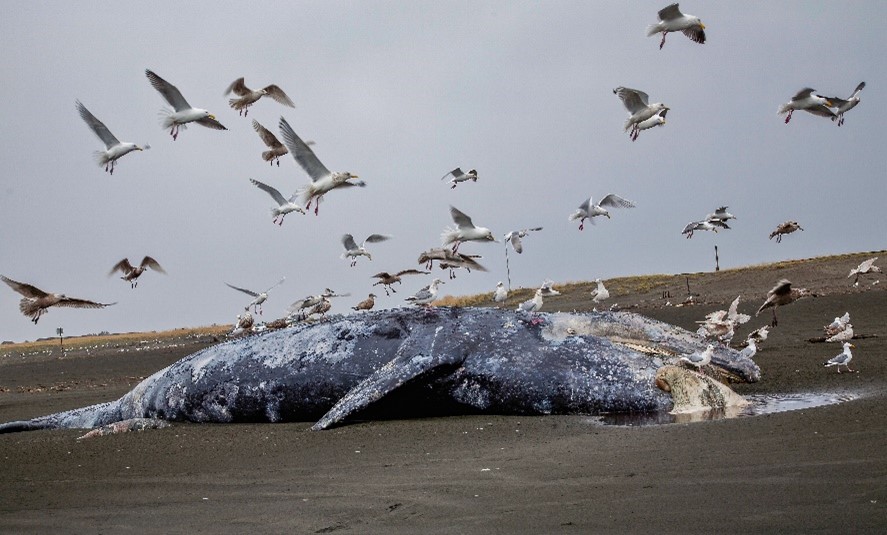
This month, the LA Times ran an in-depth and distrubing expose: “Something is killing grey whales. Is it a sign of oceans in peril?” The piece documents an alarming trend of grey whales washing up dead along the Pacific Coast. Since 2019, 481 whales have stranded along the beaches of North America, including 69 in California. Baja researchers and tour operators first started noticing gray whales arriving in Mexico about two weeks later than usual. Many of them atypically skinny — with their blowholes sunken into their backs like deflated, skin-covered bowls — and their vertebrae protruding along their spines. They also noticed very few mother-calf pairs — a pattern seen in Baja 20 years ago, the last time there was a significant die-off of gray whales.
It is true that more research needs to be done to better understand why grey whales are dying – but we also need to take action now. We know many of the causes of whale deaths: ocean acidification, ship strikes, plastic pollution, and entanglement in fishing gear. The good news is all of these stressors have solutions. Whales don’t have time for research, we must act now to protect our beloved grey whales.
Ocean Acidification. Global carbon emissions are driving changes not only to the Earth’s climate, but also to the chemistry of the world’s oceans. The oceans are acidifying (called ocean acidification) because they are absorbing a significant share of the carbon dioxide released primarily by the burning of fossil fuels and changing land uses. Some species of calcifying plankton that are threatened by ocean acidification form the base of marine food chains and are important sources of prey for whales.
The solution: prevent local ocean acidification ‘hot spots’. Scientists have determined that land-based pollution from wastewater, stormwater, and agricultural dischargers are lowering the pH of our coastal waters and causing ocean acidification hot spots – but we can prevent them! We need to develop water quality standards to prevent ocean acidification hot spots and recycle or de-nitrify the billions of gallons of wastewater we dump into our oceans annually. We also need to capture our stormwater so that it is treated as a resource rather than a pollutant. And farmers must use less fertilizers so that excess nutrient pollution doesn’t wash off agricultural fields and onto our coast.
Ship Strikes. Each year, thousands of large container ships go to and from California ports through shipping lanes that are shared by at least three endangered whale species, including grey whales. Slowing ship speeds reduces the risk of fatal ship strikes on whales, while simultaneously reducing noise pollution that also harms whales.
The solution: California should allocate $7.6 million ($1.9 million over 4 years) to allow coastal air districts, in consultation with the National Marine Sanctuary program, to develop and implement a permanent voluntary vessel speed reduction incentive program for California. The funding would support implementation of the program, including emissions calculations, whale risk reduction calculations, public relations and media, and the incentive payments.
Plastic Pollution. Eighty percent of marine plastic pollution starts on land. It gets blown by wind or carried by rain into storm drains, which flow to our bays, rivers and ocean. Once in the water, it breaks down into smaller pieces that can persist in the environment for decades, polluting the water and harming whales, fish, and animals that mistake it for food.
The solution: prevent trash from entering our waterways by removing trash in stormwater (one of several important solutions). California adopted a Trash Policy in 2015, setting a goal of no trash present in our waterways by 2030, and requiring cities to prevent trash from entering waters by placing trash catching devices on storm drains.
Fishing Gear Entanglement. Entanglements in the thick ropes that are connected to heavy commercial Dungeness crab traps injure and kill whales and sea turtles. The ropes cut into the animals’ flesh, sap their strength, and lead to drowning. Each entanglement of a humpback whale, blue whale, or leatherback sea turtle, besides causing needless suffering and loss of life, violates the federal Endangered Species Act.
The solution: ropeless gear. Ropeless fishing gear isn’t actually ropeless. It just means that the rope doesn’t hang around in the water column while fishermen wait for crabs to enter the cages, and is instead secured, along with the buoy, to the crab pot on the ocean floor, until it is summoned upwards by fishermen. Different mechanisms, such as acoustic triggers, are then used to bring rope and buoy to the surface so fishermen can collect it.
Gray whales are a success story — having survived commercial whaling and rebounded from near extinction – but they are in peril again and we need to act, now.

Executive Director Sean Bothwell leads CCKA’s initiatives to fight for swimmable, fishable, and drinkable waters for all Californians.



